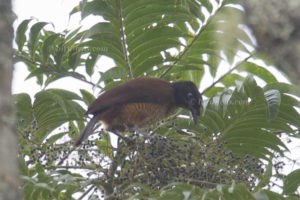 At 5:00 a.m. the night in the mountain hotel is over. 5:30 a.m. breakfast is announced. Afterwards we are guided straight to a fruiting tree to observe Birds-of-paradise at the bungalow no. 7. The inconspicuous green and black berry tufts lure Birds-of-paradise again and again. Here you might find the Lawes Parotia (Parotia lawesii). We are rewarded very fast. A female feeds intensively in the low canopy of the fruiting tree.
At 5:00 a.m. the night in the mountain hotel is over. 5:30 a.m. breakfast is announced. Afterwards we are guided straight to a fruiting tree to observe Birds-of-paradise at the bungalow no. 7. The inconspicuous green and black berry tufts lure Birds-of-paradise again and again. Here you might find the Lawes Parotia (Parotia lawesii). We are rewarded very fast. A female feeds intensively in the low canopy of the fruiting tree.
The species belonging to the genus Parotia is probably one of the most sophisticated dancers among birds and even among the Birds-of-paradise. The males of these petite birds compete on the ground and cultivate “their” place with great effort. The males are considered polygynous, i.e. they are having two or more mates, either simultaneously or successively. Parotias have promiscuous males that entertain terrestrial courts seasonally. The male cleans his arena of leaves and twigs and decorates it with snakeskin, mammal dung, chalk, fur, feathers and bones. Any leaf that falls on the empty arena is removed immediately, so nothing disturbs the upcoming performance. Sometimes the decoration of neighboring courts is stolen. When females arrive and sit down on a branch above the arena, the male begins its unique ballerina dance. With splayed feathers, which actually remind of a skirt, he trip on the floor back and forth. He shakes his head and moves his six wire-like feathers of the head, which he has now pointed forward. Then the prancing bird plays its reflective breast feathers in the forest light. The dance process is characterized by complex movements of flank plumes, pectoral shield, mantle cape, nuchal crest and occipital plumes. Neighboring males disrupt each other’s courtship. The courtship involves static and leg-flexing postures. Male performs bounce display on court perch as female approaches. The complete sequence of display consists of danced ritualized steps and body movements accompanied by intricate feather manipulations.
Papua New Guinea not only has to offer the Lawes Parotia. New Guinea is the main distribution of this family with a total of 43 species. New Guinea owes this fact the nickname “Island of Birds of Paradise. More pictures of Birds-of-paradise can be seen in the gallery of photographed species of birds of paradise during a trip in 2010.
The Ambua Lodge is in the fairly remote Tari district of Papua-New Guinea (PNG) is a lovely, traditionally-built lodge situated in the mountains with a spectacular view of the valley below. The main room is a large wood construction space roofed over in traditional thatch, and featuring magnificent totem poles carved from whole tree trunks.
The rooms are mainly traditional round huts scattered around the hotel area. These are huts, which have a nice setting down amongst the gardens and are very romantic. But recently they build modern rooms which are better insulated and drier. The weather can be very changeable, and in the afternoon the lodge is often inside clouds with frequent rain. The temperature really drops when this happens. Thus bring warm clothing. The road from the lodge into the next town is pretty bumpy.
To cope with the growing demand for top shots of the rarer species not only of the Western Palearctic, Bird-Lens is keen to enrich the range of pictures of birds you can find in the western Palearctic. Trips to remote places to capture images were very successful. The nice image of the blog is only a first impression, what you will find in the gallery in the “Picture Shop” very soon. Just give bird-lens.com a message, if bird-lens.com could serve you with an image needed before the new pictures are online.